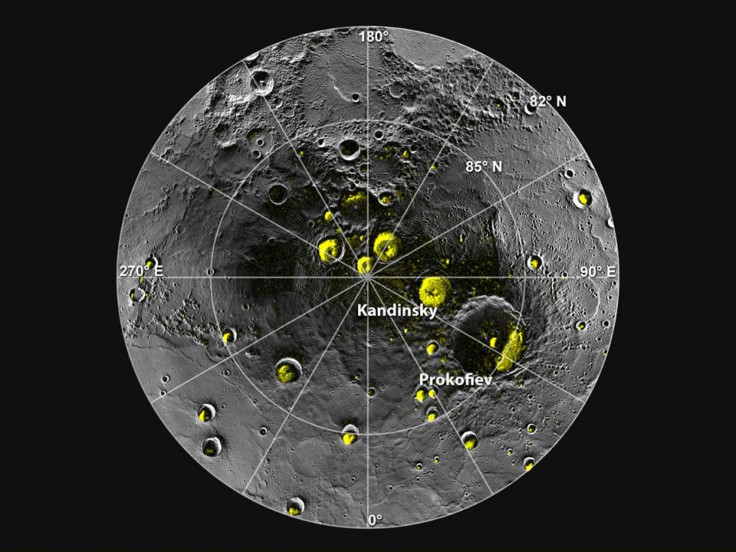Ice On Mercury: What Next?

On Thursday, there was a rare eclipse in science news. For once, Mercury shouldered Mars out of the headlines. While everyone was keeping an eye on the Curiosity rover's search for signs of an ancient sea on the Red Planet that could have supported life, scientists were collecting hard evidence that the tiny world closest to our Sun has at least one polar ice cap.
It's kind of a no-brainer that Mars has water. It has visible polar ice caps -- a mixture of both frozen water and frozen carbon dioxide -- and geological features that suggest liquid water once flowed on the planet's surface. But on Mercury, where the intensity of the Sun can mean that temperatures climb as high as 800 degrees Fahrenheit?
It appears a bit preposterous, until you take into account the fact that Mercury has almost no rotational tilt. Earth's tilt means that its poles get a dose of daylight -- either a lot or a little, depending on the season -- but because Mercury is almost rigidly straight as it spins, its poles are virtually sunless.
Scientists discovered signs that Mercury may hold as many as 1 trillion metric tons of water ice trapped in its shadowy north pole thanks to data from the Messenger spacecraft, the first probe to orbit our solar system's innermost planet. Messenger began circling Mercury in March of last year, and its mission was originally supposed to end in March of this year, but NASA extended it until at least March of next year.
"The more we examine the solar system, the more we realize it's a soggy place," NASA Planetary Science Division director Jim Green said at a press conference on Friday, according to Space.com.
NASA researchers relied on three separate lines of evidence in determining that ice exists on Mercury, which were described in a trio of papers published in the journal Science on Thursday. First, the Messenger spacecraft found more hydrogen than expected at the planet's north pole. Researchers also measured the reflectance of Mercury's poles for the first time, which involves looking at the amount of light and energy that bounces off of the surface. Using topographical data, scientists were also able to model the temperatures at the surface and near-surface of Mercury's north pole for the first time.
The Messenger data also revealed that much of the ice at Mercury's pole seems to be trapped underneath a dark material possibly made of complex organic compounds. These kinds of materials contain carbon, the most essential chemical building block for life as we know it. This aspect of the discovery now raises many new questions for researchers.
"Do the dark materials in the polar deposits consist mostly of organic compounds?” Columbia University scientist and Messenger mission researcher Sean Solomon asked in a statement Thursday. “What kind of chemical reactions has that material experienced? Are there any regions on or within Mercury that might have both liquid water and organic compounds? Only with the continued exploration of Mercury can we hope to make progress on these new questions."
Obviously, an ideal way to explore Mercury's ice cap would be to send a lander or rover that could directly sample the area. But landing something like Curiosity on Mercury presents different challenges than a mission to Mars.
Even getting orbiters such as Messenger to Mercury is hard, due to the proximity of the Sun. To get to Mercury, Messenger had to take a very circuitous route over six and a half years, including one flyby near Earth, two passes near Venus, and three flybys near Mercury before it could settle into an orbit. These flybys gave the probe a “gravity assist,” changing its orbit around the Sun and giving Messenger a boost or a brake as needed, while using less fuel.
Mercury also has a very minimal atmosphere, meaning it would be very hard to use parachutes to land a rover or lander. Mars also has a comparatively thin atmosphere, but it is at least substantial enough for parachutes to play roles in landing probes. Any Mercury lander would also have to cope with extremely hot or extremely cold temperatures.
A future mission to Mercury called BepiColombo, a joint effort of the European Space Agency and the Japan Aerospace Exploration Agency planned for launch in 2015, was going to include a small lander, but this element was canceled in 2003 for budgetary reasons.
Even with ice and organic compounds available, the chances of life ever existing on Mercury are pretty slim. Although the planet does have traces of oxygen in its atmosphere, the levels are much too low to support any form of creature familiar to us. Any potential early Mercurial life-forms would likely have been bombarded with asteroids, which wouldn't encounter any resistance from an atmosphere like that on Earth.
Still, as Jeff Goldblum's character observed in the film "Jurassic Park," “Life finds a way,” and Earth is home to its own strange extremophiles: microbes that can thrive in liquid asphalt lakes, tiny animals called tardigrades that can survive the hard vacuum of space, and bacteria that can grow without oxygen. So we won't know for sure about Mercury until we get there.
© Copyright IBTimes 2024. All rights reserved.





















